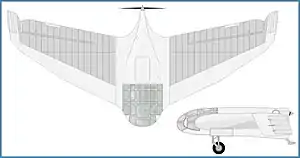DFS 40
The DFS 40 (originally developed as the Delta V) was a tail-less research aircraft designed by Alexander Lippisch in 1937 as a follow-on to his Delta IV aircraft. In construction, the DFS was closer to a flying wing than its predecessor, and was built as an alternative to that aircraft.
| DFS 40 | |
|---|---|
 | |
| Role | Experimental Tailless aircraft |
| National origin | Nazi Germany |
| Manufacturer | Deutsche Forschungsanstalt für Segelflug (DFS) |
| Designer | Alexander Lippisch |
| First flight | 1939 |
| Number built | 1 |
| Developed from | Lippisch Delta IV |
| Variants | DFS 194 |
The DFS 40 was flown for the first time by Heini Dittmar in 1939, shortly before Lippisch departed the DFS (Deutsche Forschungsanstalt für Segelflug - German Research Institute for Sailplane Flight) to begin work at Messerschmitt. Soon afterwards, without Lippisch there to supervise the project, the aircraft was crashed due to an error in center of gravity calculations that resulted in it entering a flat spin during flight.
Specifications (DFS 40)
General characteristics
- Crew: 1
- Length: 5.1 m (16 ft 9 in)
- Wingspan: 12 m (39 ft 4 in)
- Powerplant: 1 × Argus As 8 4-cyl in-line piston engine, 75 kW (100 hp)
| Wikimedia Commons has media related to DFS 40. |
This article is issued from Wikipedia. The text is licensed under Creative Commons - Attribution - Sharealike. Additional terms may apply for the media files.
